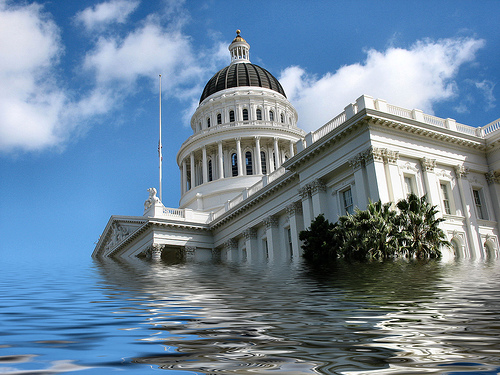We hear a lot of hot air, if you’ll pardon the pun, about whether the climate is changing or not. But this is not a game — climate change is already affecting people throughout the world. And those who have something real to lose, as opposed to political support of the tea party and coal companies, don’t have the luxury of pontificating and screwing around. They say that money talks. So it’s instructive to look at who is making decisions that involve real money to plan for the inevitable. It is hardly, as some like to suggest, a gallery of bleeding-heart liberals:
Take the South Florida Water Management District. These people don’t give fund-raising speeches to rich donors in Washington or host rabid radio talk shows. They live in the real world, where they have to make decisions about issues like where water for millions of people will come from, whether levees will hold, and so forth. From the Sun-Sentinel:
“The South Florida Water Management District estimates that sea levels could climb 5 to 20 inches during the next 50 years. The NRDC [Natural Resources Defense Council] report warns of a larger sea level threat for Miami — a 1.5- to 2.3-foot sea-level increase by 2050 and 3 to 5 feet by 2100. The projections are more severe for the Florida Keys, which could lose more than 90 percent of land area to rising seas by 2100. Across the region, water managers already have identified 28 flood-control structures along the southeast coast and six along the west coast at risk of not working properly because of rising sea levels.”
Not convinced? How about the United State Military? Here’s what the military’s top strategic thinkers said a few years ago, as reported by that liberal rag the New York Times Army Times:
“Global warming isn’t often thought of as a matter of interest for the U.S. military. But it should be, an advisory board of 11 retired flag officers concluded in a report issued Monday under the auspices of the Center for Naval Analyses, a non-profit national security analysis group. Climate change is happening, the blue-ribbon panel concluded, and is a “serious national security threat.” Extreme weather would be disruptive to the military in and of itself, more frequently driving Navy ships to sea to skirt hurricanes or blinding combat units preparing to attack somewhere overseas. But the board found that climate change “acts as a threat multiplier for instability in some of the most volatile regions of the world.” Projected climate changes will “add to tensions even in stable regions.” For instance, global warming will worsen third-world living conditions, with the problems ranging from drought as well as flooding to the spread of infectious diseases. This, the report concludes, would lead to “widespread political instability and the likelihood of failed states.” Internal conflict and extremism could easily follow.”
What about American business–the titans that run our economy? The insurance industry certainly gets it, as reported in 2008 by Insurance Journal:
“Potential climate change is the greatest strategic risk currently facing the property/casualty insurance industry . . .Ernst & Young and Oxford Analytica interviewed more than 70 industry analysts from around the world to identify the emerging trends and uncertainties driving the performance of the global insurance sector over the next five years. The study identified risks in three broad areas — macro, sector-specific and operational threats. It identified the top ten risks and five emerging threats. The analysts told Ernst & Young these are the strategic risks that industry leaders must manage if they are to maintain dominant competitive positions.”
Indeed several insurance companies have stopped writing policies for coastal regions in the southeastern USA due to perceived growing risks from climate change. For example, Farmers Insurance stopped writing policies for North Carolina in 2008, forgoing US$55 million in annual premiums because of the risk of losses associated with storms and flooding, and premiums increased by 42-77 per cent in nine Southern states between 2001 and 2006. They gave up $55 million in premiums. I would love to hear the convolutions Rush Limbaugh would go through to turn that into a liberal conspiracy.
So who are these people who don’t get it yet? Alas . . .


Leave a Reply